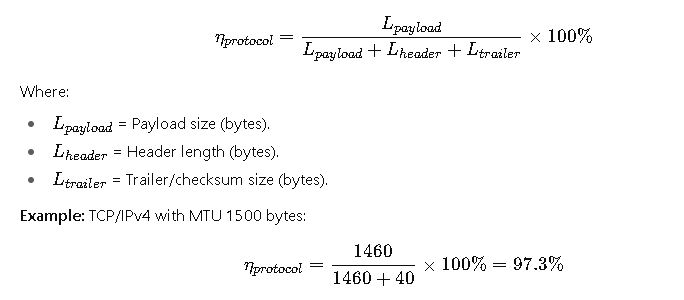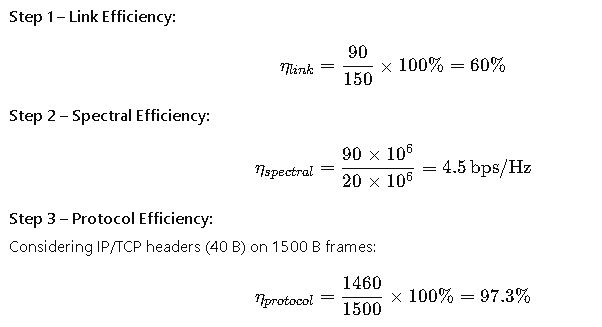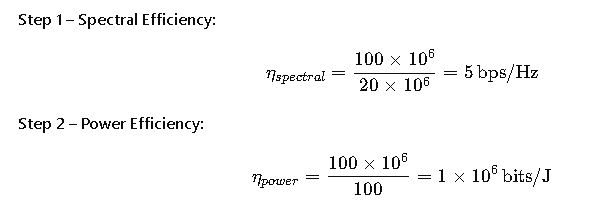Data transmission systems form the backbone of communication, enabling reliable information transfer across multiple media technologies. Their performance depends on efficiency, measuring resource utilization like bandwidth, power, and time with minimal overhead.
Data Transmission Efficiency Calculator
Compute Link Efficiency (%), Spectral Efficiency (bits/s/Hz), and Energy Efficiency (bits/Joule) — ideal for network engineers and researchers.
What is Link Efficiency?
What is Spectral Efficiency?
What is Energy Efficiency?
Formulas used
Spectral efficiency: ηspec = R (bits/s) / B (Hz) = (R (Mbps) × 1e6) / (B (MHz) × 1e6)
Energy efficiency: ηenergy = R (bits/s) / P (W) = (R (Mbps) × 1e6) / P (W)
Why Efficiency Matters in Data Transmission
Efficiency directly affects the capacity, cost, and sustainability of communication networks:
- Higher throughput with minimal resource waste.
- Lower energy consumption in mobile and IoT devices.
- Better spectral utilization in crowded radio environments.
- Reduced latency and improved Quality of Service (QoS).
Key Efficiency Metrics
Efficiency in data transmission systems can be expressed in several dimensions:
- Link Efficiency (%) – Ratio of useful data bits to total transmitted bits.
- Spectral Efficiency (bits/s/Hz) – Throughput achieved per unit bandwidth.
- Power Efficiency (bits/J) – Bits successfully transmitted per joule of consumed energy.
- Protocol Efficiency (%) – Fraction of transmitted data not consumed by headers, acknowledgments, or retransmissions.
Extensive Tables of Common Efficiency Values
The following tables summarize widely used values in different transmission environments.
Table 1: Typical Link Efficiencies in Communication Systems
| System / Technology | Data Rate (Mbps) | Channel Bandwidth (MHz) | Efficiency (%) | Notes |
|---|---|---|---|---|
| Ethernet 100BASE-T | 100 | 31.25 (symbol rate) | 97–99 | Low overhead, wired LAN |
| Wi-Fi 802.11b | 11 | 22 | 40–65 | High protocol overhead |
| Wi-Fi 802.11n (MIMO, 40 MHz) | 300 | 40 | 70–80 | Depends on guard intervals |
| LTE (4G, 20 MHz channel) | 100 | 20 | 75–85 | With advanced coding |
| 5G NR (100 MHz channel, mmWave) | 2000 | 100 | 80–90 | Massive MIMO improves |
| Satellite DVB-S2X | 50 | 36 | 60–80 | Weather-dependent |
| Fiber Optic (DWDM channel, 100 Gbps) | 100000 | 50 GHz spacing | 95–98 | Excellent spectral efficiency |
Table 2: Spectral Efficiency of Common Modulation Schemes
| Modulation Type | Bits per Symbol | Required SNR (dB) | Spectral Efficiency (bps/Hz) | Common Usage |
|---|---|---|---|---|
| BPSK | 1 | ~7 | 1 | Satellite links, IoT |
| QPSK | 2 | ~10 | 2 | LTE, Wi-Fi |
| 16-QAM | 4 | ~16 | 4 | DSL, Wi-Fi, LTE |
| 64-QAM | 6 | ~22 | 6 | LTE-Advanced |
| 256-QAM | 8 | ~28 | 8 | Wi-Fi 6, DOCSIS 3.1 |
| 1024-QAM | 10 | ~32 | 10 | 5G NR, future standards |
Table 3: Protocol Overhead and Efficiency
| Protocol / Standard | Header Size (Bytes) | Typical Payload Size (Bytes) | Efficiency (%) | Notes |
|---|---|---|---|---|
| TCP over IPv4 | 40 | 1460 | 97.3 | Without options |
| TCP over IPv6 | 60 | 1460 | 96.0 | Larger header |
| UDP over IPv4 | 28 | 1460 | 98.1 | Lower overhead |
| Ethernet Frame | 18 | 1500 | 98.8 | Incl. CRC, MAC |
| VoIP RTP/UDP/IP | 40 | 20–160 | 33–80 | Very payload dependent |
Mathematical Formulas for Efficiency
Let us now derive and explain the core formulas used in efficiency calculation.
1. Link Efficiency

Typical values:
- Wired LAN: 95–99%
- Wireless (high interference): 40–80%
2. Spectral Efficiency

Typical values:
- Narrowband IoT: 0.2–0.5 bps/Hz
- 5G NR (mmWave massive MIMO): 10–30 bps/Hz
3. Power Efficiency

Typical ranges:
- IoT devices: > 1 Mbit/J
- Base stations: 10–100 kbit/J (depending on cooling and RF losses)
4. Protocol Efficiency

5. Shannon Limit for Maximum Efficiency
From Shannon’s theorem:

Spectral efficiency upper bound:
This sets the theoretical maximum; real systems achieve only a fraction.
Real-World Case Studies
To illustrate efficiency calculations, let’s analyze two detailed cases.
Case Study 1: Efficiency of a Wi-Fi 802.11n Link
Scenario:
A laptop connects to a router using 802.11n at 150 Mbps over a 20 MHz channel.
- Net throughput observed: ~90 Mbps (due to overhead and retransmissions).
- Bandwidth: B=20 MHz

Interpretation:
Even with strong physical modulation, efficiency is limited by protocol overhead and wireless interference, resulting in ~60% real throughput efficiency.
Case Study 2: LTE (4G) Spectral and Power Efficiency
Scenario:
An LTE base station operates with a 20 MHz channel, providing 100 Mbps throughput. Average power consumption = 100 W.

Interpretation:
LTE achieves excellent spectral efficiency (~5 bps/Hz), but relatively modest power efficiency compared to IoT devices, where battery life is a priority.
Factors Influencing Efficiency in Data Transmission
Efficiency in data communication systems is shaped by a combination of physical, protocol, and operational factors. Below are the most influential ones:
- Modulation and Coding: Higher-order modulation provides better spectral efficiency but requires stronger signal-to-noise ratios.
- Protocol Overhead: Headers, trailers, acknowledgments, and retransmissions reduce net throughput.
- Error Control Mechanisms: Forward error correction improves reliability but adds redundancy.
- Multiple Access Methods: Techniques like TDMA, FDMA, or OFDMA affect how resources are shared among users.
- Interference and Noise: Wireless systems are particularly vulnerable to efficiency losses from interference.
- Latency: In high-latency environments such as satellite links, protocol efficiency drops without optimization.
- Energy Constraints: In mobile and IoT systems, energy efficiency is often prioritized over throughput.
Trade-Offs in Efficiency Optimization
Improving one type of efficiency often reduces another. Understanding these trade-offs is crucial for system design:
- Spectral vs. Power Efficiency: High-order modulation increases spectral efficiency but consumes more power.
- Link Efficiency vs. Latency: Heavy error control improves link efficiency but increases delay.
- Protocol Efficiency vs. Flexibility: Rich protocol headers carry useful features but reduce efficiency.
- Coverage vs. Throughput: Increasing transmission range often reduces throughput efficiency due to stronger coding and lower modulation orders.
A well-designed transmission system finds the right balance depending on application requirements.
Methods to Improve Efficiency in Transmission Systems
There are several proven strategies to enhance efficiency in practice:
- Adaptive Modulation and Coding (AMC): Dynamically adjusts modulation and coding schemes based on channel quality, maximizing throughput while keeping error rates manageable.
- Compression Techniques: Payload compression reduces the number of bits transmitted without losing information.
- Efficient Framing and Aggregation: Protocols like Wi-Fi use frame aggregation to send multiple payloads in one frame, reducing overhead.
- Error Correction Optimization: Using advanced forward error correction codes improves reliability without excessive redundancy.
- Resource Scheduling: Intelligent scheduling in OFDMA systems ensures bandwidth is allocated to users most efficiently.
- Energy-Aware Transmission: IoT networks use duty cycling and sleep modes to reduce energy consumption while maintaining connectivity.
Practical Step-by-Step Guide for Engineers
When engineers need to evaluate the efficiency of a data transmission system, they usually follow these steps:
- Define the Transmission Scenario
- Type of system: wired, wireless, satellite, optical, IoT.
- Required performance: throughput, coverage, energy consumption.
- Measure the Raw Data Rate
- Record the maximum theoretical rate from system specifications.
- Measure the Net Throughput
- Conduct real-world tests to see how much useful payload is delivered.
- Evaluate Bandwidth Usage
- Compare achieved throughput against allocated spectrum.
- Calculate Protocol Overhead
- Analyze headers, control information, and retransmissions.
- Assess Energy Consumption
- Measure power consumption and relate it to delivered data.
- Identify Bottlenecks
- Check whether losses are due to physical layer, protocol, or energy constraints.
- Implement Optimizations
- Adjust modulation, reduce protocol overhead, or apply compression depending on findings.
Industry Standards and Regulatory Context
Efficiency benchmarks are defined and monitored by global organizations. Some of the most relevant ones include:
- IEEE 802 family: Governs Ethernet and Wi-Fi efficiency at the link and physical layers.
- 3GPP standards: Define LTE, 5G NR, and upcoming 6G efficiency targets, particularly spectral efficiency in crowded radio environments.
- ITU-T recommendations: Cover data transmission protocols, error control mechanisms, and global interoperability.
- IETF RFCs: Define Internet protocols like TCP, UDP, and IPv6 that influence protocol efficiency.
By adhering to these standards, vendors ensure their systems deliver consistent and optimized performance across networks.
Emerging Trends in Efficiency Improvement
As communication systems evolve, efficiency metrics are being pushed further through innovation:
- Massive MIMO (Multiple Input, Multiple Output): Increases spectral efficiency by transmitting multiple data streams simultaneously.
- Beamforming: Directs radio energy precisely, reducing interference and improving efficiency.
- Network Slicing in 5G: Allocates resources dynamically for different use cases, improving overall system utilization.
- AI-Driven Resource Management: Machine learning models optimize scheduling, modulation, and power allocation in real time.
- Quantum Communication Research: Promises extremely high spectral efficiency using entanglement-based techniques, though still experimental.
